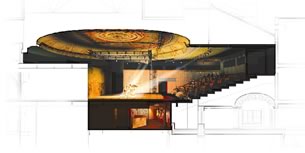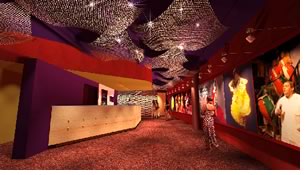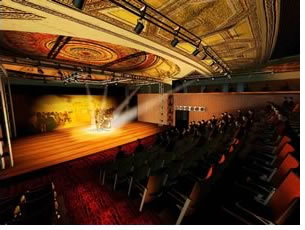

01/2005
New life given to theater and theater company alike
By all accounts, it seemed as though the curtain had closed for good on Washington, D.C.’s historic Tivoli Theater. Designed by New York architect Thomas W. Lamb and built in 1924 by owner Harry Crandall, the Italian Renaissance Revival theater was for many years one of Washington’s premiere movie houses. Located in the once tony neighborhood of Columbia Heights, the theater enveloped 2,000 patrons in opulence and splendor. After the devastating 1968 riots following the death of Dr. Martin Luther King Jr., the Tivoli remained open but was heavily scarred. Unfortunately, the subsequent suburban exodus knelled its demise. In 1975, the Tivoli enjoyed its last encore. For decades it stood dormant, a monument to the neighborhood’s past grandeur.
A worthy tenant
Founded in 1976 by Hugo and Rebecca Medrano, GALA (Grupo de Artistas
Latinoamericanos) Hispanic Theater has staged more than 150 Spanish
and bilingual productions in the D.C. community and is arguably the
country’s leading Hispanic theater company. Through its nearly
three decades, GALA has garnered critical and popular success as it
produced Spanish and Latin-American works and cultivated relationships
with actors in Argentina, Cuba, Mexico, Spain, Venezuela, and other
Caribbean and Latin American nations. GALA also partners with the Washington
Performing Arts Society to explore important social issues including
AIDS, identity, race, immigration, and gender. In addition, GALA works
with community organizations to offer workshops, internships, and performance
opportunities to youth ages 13–17. GALA has received numerous awards,
including five Helen Hayes awards, the Mayor’s Arts Award, and
the Award for Excellence in Entrepreneurship and Community Involvement.
 Since its first production at Georgetown Visitation Preparatory School,
the theater company has performed in numerous temporary spaces, including
an Adams Morgan townhouse, a church, the Lansburgh Arts Center (now home
to Washington’s Shakespeare Theatre), and a Catholic school. Although
GALA never possessed the funds for a permanent home, they fortunately
maintained a loyal audience who willingly followed them from site to
site.
Since its first production at Georgetown Visitation Preparatory School,
the theater company has performed in numerous temporary spaces, including
an Adams Morgan townhouse, a church, the Lansburgh Arts Center (now home
to Washington’s Shakespeare Theatre), and a Catholic school. Although
GALA never possessed the funds for a permanent home, they fortunately
maintained a loyal audience who willingly followed them from site to
site.
Meanwhile, the Tivoli Theater remained unable to secure a willing tenant despite its listing on the National Register of Historic Places in 1985. Although numerous developers submitted plans to renovate the Tivoli, all bids were rejected. As years gave way, so did the Tivoli’s beautiful Beaux-Arts interior.
It all comes together
Finally, in 1999, the District of Columbia selected developer Horning
Brothers to revitalize the landmark theater and create Tivoli Square,
a mixed-use project intended to spark renewal in Columbia Heights.
GALA had been interested in the site for several years and had previously
worked with other developers to secure a plan for the theater. Horning
chose GALA from 12 applicant organizations to be the cultural anchor
in the new Tivoli Square.
The developer initially wanted to place the new theater in a small street-level space. David Greenbaum, FAIA, vice president, SmithGroup says, “We wanted to create an architecture that expresses GALA’s mission, that communicated the essence of what GALA is about.” Responding to that desire, SmithGroup instead proposed placing the stage under the Tivoli’s magnificent dome and inserting a floor just under the original balcony, preserving a piece of the original performance space for the audience. They also incorporated a bold color scheme to reflect the spirit and energy of the Latino community.
 Although the space had severe limitations, SmithGroup responded creatively
to the challenges. They inserted walls on either side of the balcony
to create a feeling of intimacy and tucked the lobby and dressing rooms
under the performance area. They used a mixture of glass and metal scrims
to offer privacy while creating a sense of openness. Although the footprint
of the new 270-seat GALA Theater is approximately 25 percent of the original
Tivoli, it responds well to the distinct type of productions that GALA
presents. “The architectural language is at once traditional and
Modern to reinforce GALA’s character as a performing arts company,
which ranges from classical to contemporary. The new architecture’s
slightly gritty, urban feel contrasts with the restored Beaux-Arts decorative
plaster ceiling and walls,” says SmithGroup. Although not all battles
were won, the design team feels a great sense of accomplishment that
they were able to preserve Tivoli’s original proscenium and splendid
dome. “This theater is very important to the neighborhood. We wanted
to preserve the dome as a community asset,” notes Greenbaum.
Although the space had severe limitations, SmithGroup responded creatively
to the challenges. They inserted walls on either side of the balcony
to create a feeling of intimacy and tucked the lobby and dressing rooms
under the performance area. They used a mixture of glass and metal scrims
to offer privacy while creating a sense of openness. Although the footprint
of the new 270-seat GALA Theater is approximately 25 percent of the original
Tivoli, it responds well to the distinct type of productions that GALA
presents. “The architectural language is at once traditional and
Modern to reinforce GALA’s character as a performing arts company,
which ranges from classical to contemporary. The new architecture’s
slightly gritty, urban feel contrasts with the restored Beaux-Arts decorative
plaster ceiling and walls,” says SmithGroup. Although not all battles
were won, the design team feels a great sense of accomplishment that
they were able to preserve Tivoli’s original proscenium and splendid
dome. “This theater is very important to the neighborhood. We wanted
to preserve the dome as a community asset,” notes Greenbaum.
Home at last
Some 81 years after it opened, 29 years since it closed, and 5 years
since D.C. selected the developer, the Tivoli is once again the toast
of the town. With the official opening on January 7, the GALA Theater
at last has a place to call home. “We have continually been on
the frontier, on the fringe,” says Rebecca Medrano. “At
the Tivoli, we’re finally in the right place at the right time.”
The invigorated GALA plans to expand its offerings in the coming season: They will eliminate headphones used for translation and instead offer supertitles to enhance accessibility and impact. The new theater will host a library and archive, rehearsal and workshop space, film projection facilities, and exhibit space for visual artists. “This was a project that no one wanted to leave alone,” notes Greenbaum. “We had such an enthusiastic and committed client. We all loved working on it.”
Copyright 2005 The American Institute of Architects.
All rights reserved. Home Page ![]()
![]()
 |
||
In addition to the GALA Theater, the new Tivoli Square will offer mixed-use retail and commercial space, a full-service supermarket, 40 condominiums, and above-grade parking for 230 cars. All images courtesy of SmithGroup, Inc. AIArchitect thanks David Greenbaum, FAIA, vice president, and Gwyn Jones, marketing manager, SmithGroup, for their assistance with this article. Architecture, restoration,
and engineering partners: Development team:
|
||
